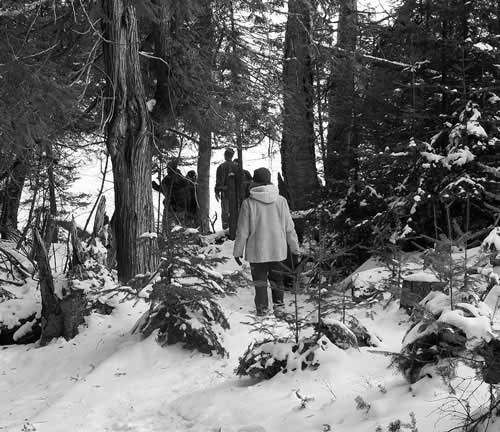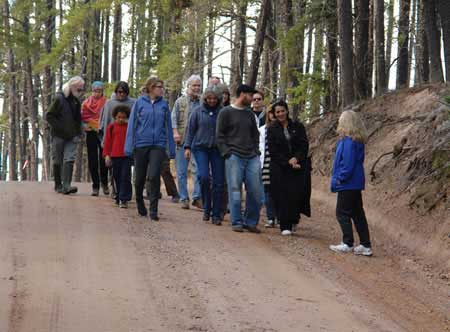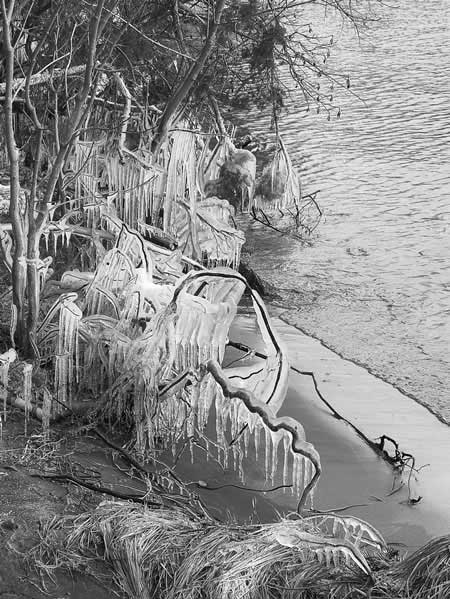from Marquette Monthly December, 2014
By Jon Magnuson
It’s late Saturday morning. I’m making my way along with six others, breaking trail through two feet of snow. We’re weaving our way down a ridge running through a hemlock forest on the north end of the Bayfield Peninsula in northern Wisconsin. The sun is glistening, the air brisk, clean.
It’s closing day for a Lake Superior Binational Forum meeting held on the Red Cliff Indian Reservation. The forum, an advisory group initiated in 1991 by the International Joint Commission, was organized to enlist feedback from twenty-four citizens representing different sectors, including the business, environmental, Native American, educational and faith communities. Its purpose has been to make periodic formal recommendations to both the Canadian and United States governments on how to help protect the water and natural resources of the Lake Superior Basin more responsibly.
Two years ago, after a long, bitter debate about natural resources, Canada withdrew its funding for the forum. It appears, due to shifting government priorities and our own gridlocked federal government, this could be our last formal gathering.
At the end of the meeting, a few of us chose to accept a tribal member’s invitation to explore, for a couple of hours, a specific area of the Red Cliff Reservation: Frog Bay, a beautiful, rugged forested area of eighty-nine acres, recently set aside by an agreement between the state and the federally-recognized Red Cliff community as a tribal national park.
We walk in each other’s footprints, boots compacting a fresh singular pathway in the snow, weaving our way under snow-dusted cedar boughs and around fallen birch trees. In spite of doing my best to be fully in the moment, I can’t keep out of my mind a conversation from a couple of nights before over pizza at a Bayfield café.
A volunteer on the forum, a former staff worker with the United Nations, now a documentary filmmaker, joined my wife Diana and me for a modest meal. We learned she has a long-standing and trusted relationship with a nearby tribal community where she lives with her husband, the director for the tribe’s health department.
We talked at length about her volunteer work this past summer with a museum located on Madeline Island, the best known of the Apostle Islands archipelago. I knew Madeline Island is regarded as a sacred site by many Native Americans in the Great Lakes Basin, understood to be the original site for the beginnings of Upper Great Lakes Ojibwe culture and its traditional religion, the Midewiwin. Here’s the story she told us:

In the 1850s, the Ojibwe people of the region were informed they were to be relocated near what is now Sandy Lake (Wisconsin), a fair distance south. A delegation of tribal people, including a translator, chose to travel to Washington D.C. to protest and try to persuade officials they should be allowed to remain in their present home. They began their journey in birch bark canoes. Among the delegation was Chief Buffalo, then ninety-two years old. He carried a ceremonial pipe with him, intended to be a gift for President Millard Fillmore. Arriving in the capitol, they were told initially a private audience with the President would be impossible. But circumstances fell into place over a matter of hours, in what some might deem a mystical way, and a meeting with President Fillmore did occur. The pipe, carried from Madeline Island, was smoked ceremonially between them.
After an afternoon of extended conversation, the President rescinded the order to relocate the Ojibwe and agreed they should remain in their homes on their traditional lands, now the Bad River and Red Cliff Indian reservations.
That was 1852. Fast forward to 2012. That year, on the anniversary of the journey to Washington, the pipe, presumed lost over the years, suddenly reappeared. In 2012 Ojibwe people honored it during a ceremony in Duluth. (No photos were permitted.) The following year it was brought back, again to Madeline Island.
We have come to know that on the way back to Madeline Island in 1852, Chief Buffalo gave the pipe to his son-in-law Benjamin Armstrong in appreciation for Armstrong’s interpreting skills during their visit in Washington. For more than 150 years the Armstrong family had quietly served as guardians for the pipe; then in 2009 it was returned to Ojibwe descendants of Chief Buffalo. The Ojibwe now are guardians for this deeply cherished and powerful ceremonial pipe. It remains a sign of promise, restoration and hope for Native tribes across the Northern Great Lakes.
The Bad River band of the Ojibwe is now fighting again to preserve its home. There is a proposed open pit iron mine targeted for nearby Penokee Hills. The tribe has organized regional and national support. It maintains the proposed mine waste would destroy traditional wild rice beds and impact water quality for hundreds of years to come.

Here in Michigan’s Upper Peninsula, there are similar ongoing, and sometimes contentious, conversations about what our economic, cultural and environmental future will be. Ten years ago, during a meeting of the forum at Twin Harbors (Minnesota), a real estate businessman approached me after a public presentation on lakeshore development with these words: “Don’t let them do to the Upper Peninsula what has happened here on Minnesota’s north shore.” He continued, “Miles of natural, beautiful Lake Superior shoreline were open to the public for more than a hundred years. It’s now privately owned and increasingly being developed. For twenty-three miles along the lake, the public can’t even access the water because of a blight of commercial development and high-priced condominiums.”
I well remember him. He was a successful businessman, but also seemed to feel chosen to serve as one of the guardians of our waters and what’s left of our natural resources. There are certain individuals, I’ve discovered, drawn to this peculiar vocation of advocacy. It is, for many of them — and they will admit it — a kind of “calling.”
Those of us who are, or have been, in some position of leadership in the religious community often speak about the importance of “vocare,” Latin for “being called.” It’s unfortunate that the real power in this traditionally revered term still used in many religions remains confusing for many.
One of the distortions of the meaning of that word, according to reformers such as the sixteenth-century reformer Martin Luther, is that vocare was often too narrowly interpreted as meaning “religious vocations.” It should not be so, Luther and his colleagues asserted. He, along with his rebellious Protestant colleagues, claimed unabashedly with fierce boldness that there is as much dignity and sacred power in the vocation of one who is pulling a cart of manure down a village street as anyone who presides during a Mass wearing a bishop’s robe.
Luther will be remembered by many, if for nothing else, by how he applied that conviction to political counsel. “I would rather have a wise pagan as my prince,” he wrote, “than a foolish Christian.”
• • •
It’s approaching midday. Our group is threading its way down from the snow-covered highlands through a heavy canopied forest, the trail twisting, sloping downward to the shores of Lake Superior.
Our guide suddenly stops and points to the snow. “Bear tracks. She’s moving just ahead of us,” he says matter-of-factly. Kneeling down, his glove traces a round paw print the size of his gloved hand.
In the world of psychology and myth, the bear has long represented an archetype for nurture, protection. It is Finland’s national animal, and during earlier periods of that culture, the bear was revered so highly it was referred to only by synonyms. The bear is regarded as a formidable and fierce guardian for her cubs, but also, in a larger sense, for all of life.
And this great, powerful force in nature has been appropriated in myth and legend not only as a guardian, but as female. Is it any coincidence that the most historically renowned guardians of the weak and vulnerable, of nature and human health have been women?

Rachel Carson, a marine biologist who, fifty years ago, forever changed the way we regard the natural world, embodied this kind of spirit. In 1962, The New Yorker published the first of three installments of her forthcoming book Silent Spring. Immediately, Carson became a lighting rod for controversy and vitriolic battles about the impact of toxins and pesticides on human health. At that time, DDT (a popular pesticide) was being widely used in North America and around the world for agriculture, malaria eradication, and, of course, lawn care. It also was, Carson concluded from her scientific studies, killing songbirds and poisoning children.
Public debate about this issue established a basic ongoing dynamic between industry and the emerging environmental movement that continues to this day. Paul Hawkin relates, in his book Blessed Unrest (2007), attacks on Carson for her research became not only personal, but bitter and relentless by those financially vested in and profiting from the chemical industry. Former Secretary of Agriculture Erza Benson sarcastically asked, “Why would a spinster with no children be interested in genetics?”
Time Magazine summarily dismissed Silent Spring as “… an emotional and inaccurate outburst.” In spite of the criticism, Hawkins notes Carson, though her last years were spent in a wheelchair, never spoke angrily or aggressively. “Her voice,” he writes, “remained measured, calm, dignified.”
Two years after the publication of Silent Spring, Rachel Carson died from cancer. It was 1962. She was fifty-six years old. She left a third of her estate to the Sierra Club. In 1968, the United States Environmental Protection Agency was established, in no small measure due to the national conversation born from Carson’s research and a new, chilling consciousness beginning to emerge around connections between human health and polluted environments.
The guardians among us frequently identify themselves as part of nonprofit organizations, but first and foremost they are individuals. Here in Michigan’s Upper Peninsula, I’ve come to discover they come from all walks of life, and the vast majority, one soon discovers, know how to do their homework.
As members of environmental advocacy groups and often as individuals, they come prepared with facts and evidence challenging the status quo. I’ve attended dozens of public hearings. I’ve noticed mining company representatives and officials from international wood product corporations rarely speak publicly at these events.
Sometimes, I have come away wondering whether such sophisticated, well-funded entities are prepared to counterpoint evidence regarding health and environment presented by the public opposition. I also have observed when they do, these company spokespersons, very skilled in communication, never remain in the community, but are transferred to other projects and “hot spots” across the country and overseas.

In 2009, Lois Gibbs, an activist and one of the most respected environmental guardians in the twentieth century, visited Marquette, invited by a group of citizens questioning a proposed international mining operation.
In 1978, Gibbs was a young mother in upstate New York. She became aware of the high incidence of miscarriages and children in her neighborhood being born with health problems and birth defects.
With no prior experience in community activism, Gibbs organized her neighbors, forming the Love Canal Homeowners Association. She led her community in a battle against local, state and federal governments. After years of struggle, 833 families eventually were evacuated, and cleanup began. National press coverage made Lois Gibbs a household name.
During her time with us, she spoke modestly, self-depreciatingly about her own role organizing her community, yet riveted the audience with the story of how she and a group of local citizens and children forced one of the largest petroleum companies in North American to address issues of contamination, toxic waste and environmental degradation at Love Canal, just outside Niagara Falls.
• • •
We’re emerging, now, from the forest onto a shoreline facing east across the bay. On the horizon, less than a mile away, is Oak Island. South of us, three miles distant, are the mist-covered, heavily wooded shores of Madeline Island.

Our group gathers for a few minutes to take a break and examine ice formations along the bay’s shoreline. Our guide speaks to us about the retired couple who owned this land previously. They were not of American Indian descent, but offered the land, via a third party, for the tribe’s use and care. They knew they were approaching the last years of their lives, and decided to sacrifice a more sizable financial profit and instead negotiate with the Red Cliff tribal council a way to protect this extraordinary landscape. They most likely never used the word “guardian.” No matter. They were doing the work: protecting and ensuring a resource for those who will come after.
I’ve found most guardians are not on anybody’s payroll. They speak for many of us, but in public are marginalized unfairly, and ridiculed by those in power. They weep on behalf of us all. They see things. Some are small business owners; others are housewives, poets, university professors, nurses, artists, carpenters and musicians. Many are retired, and finally free to speak, unhindered by consequences from differently-minded employers. Such guardians, though unheralded, help us remember there are things which cannot be bought and sold, and invite us to marvel at the land and waters that surround us.
During December days, give thanks for those who serve as guardians for children, for clean water and healthy food, for a commitment to life here in the Upper Peninsula that envisions a simpler way of living, in itself a form of wealth.
From the pen of Kathleen Heideman, written at a family cabin on the Yellow Dog Plains in Powell Township, here is a voice of one who lives among us.
First publicly read this October while a first snow fell gently on those gathered around a fire for a time of prayers and song. Pondering, on behalf of us all, how we will choose to live with one another on this earth.
“How much will you give me for Fall’s first-fallen red maple leaf?
What’s the going rate for a wolf print, claws and all, in damp sand?
Have you ever found a stone arrowhead, held it knife-sharp in your palm?
What’s the monthly payment plan spread out over 25 years?
for the arrow-tipped silhouettes of black spruce standing around a copper-burnished pond? When I hear the wolf howl, hidden in shadow,
I imagine its eyes growing wide as a boy soprano’s, terrified
by its own song, emerging—a pure and hungry music.
Can you name any better rate of return?
When the wolf howls, the exchange rate soars
And everything in the forest grins
Or quits breathing for four square miles.”
––Jon Magnuson
• • •
Editor’s Note: Jon Magnuson is director of the Cedar Tree Institute, a nonprofit organization providing services and initiating projects in the areas of mental health, religion and the environment. The institute currently is working with five Upper Peninsula American Indian tribes to help recover native plants and protect pollinators, in partnership with the United States Forest Service.
